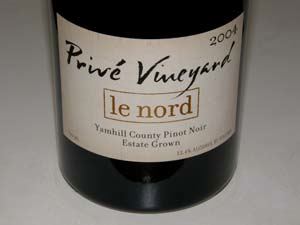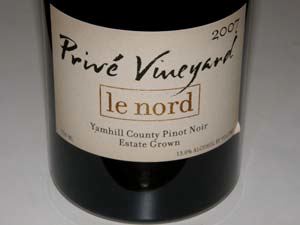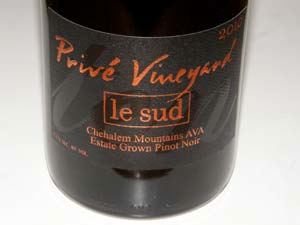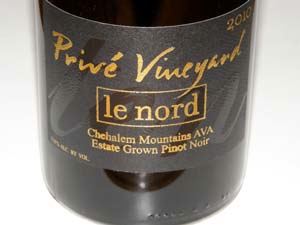Privé Vineyard: French Flavor in the Chehalem Mountains
In 2006 I first made a journey to Privé Vineyard in Newberg, Oregon, with visions of Pinot Noir dancing in my
head. My arrival was signaled by two aged wine barrels next to a sign reading, “Rue de Privé,” and I knew I
had found a slice of France in the Chehalem Mountains. Behind a gate and straddled on the northern and
southern side of a home sat two well-groomed one-acre vineyards. A sport court and a boules court
surrounded by lavender indicated some fun was to be had here. Heading up the driveway, I was taken by the
cutest little French-styled winery I had ever seen. The owners of Privé Vineyard, Mark and Tina Hammond, are
American, but their Privé Vineyard is every bit French in name (“private or independent”) and character.
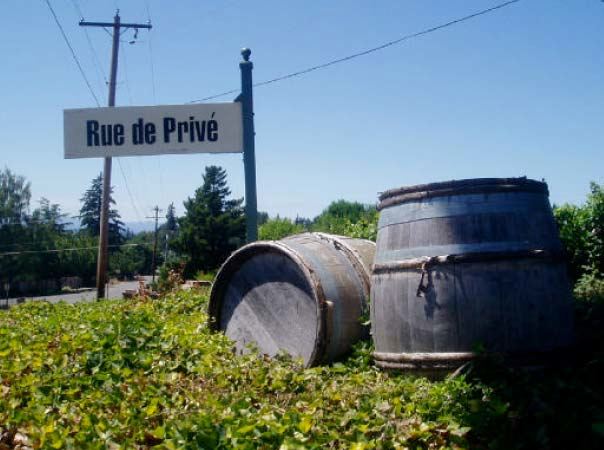
Privé Vineyard is a very small producer of Oregon Pinot Noir and is essentially a private winery for those lucky
enough to be members of the winery’s allocation list. Mark is the vineyard steward and Tina is the winemaker,
and together they produce the closest thing Oregon has to a cult Pinot Noir. The vineyard and winery are truly
a family run estate, with outside help only enlisted to help pick grapes at harvest.
The original Müller-Thurgau vines on the property were planted in Jory soil in 1980, and grafted over to Pinot
Noir by the Hammonds beginning in 1995 with Pommard clone. The vines are meticulously farmed organically
and yields are less than 2 tons per acre. In 2010 and 2011, the Hammonds made a conscious effort to pull
back vigor and the resulting wines are more fruit forward. They believe that a subtle herbal note in the 2009
wines may have been secondary to excessive vigor.
Four Pinot Noirs are currently released, three of which are estate grown. Le nord is from the upper, northern
one acre, le sud is from the lower elevation, southern one acre, and a reserve named Joie de Vivre (Joy of
Life) is crafted in half-barrel quantities and presented in an etched bottle. A Willamette Valley blend sourced
from several Oregon Pinot Noir vineyards rounds out the lineup. Of the estate Pinot Noirs offered, le sud
ripens faster and is picker at a slightly higher Brix, but in 2010 and 2011, the cooler vintages caused le nord to
ripen quicker and that was picked at a higher Brix.
The Willamette Valley blend was added in 2009 as an everyday wine that could be offered to visitors to the
winery since the estate Pinot Noirs sell out quickly every year. The blend is a notch up in ripeness over the
estate wines and more fruit-forward. Generally, three vineyards that meet the Hammonds’ high standards are
sourced, but the vineyards change from year to year. The wine is very popular and they sell more of it than the
le nord and le sud combined.
The Hammonds’ business model is such that a bad vintage could severely hamper their income. Tina has
begun to produce varietals other than Pinot Noir from sourced grapes to supplement their Pinot Noir output and
meet her customer demands. She has been playing with Syrah from Walla Walla, Washington, of late and
likes what she has produced. Tina likes to joke that if they had a miserable vintage at Privé Vineyard, Mark
would have to get a real job. They kid each other about what each one would do. Mark thinks he might pump
gas (required by gas station employees in Oregon) because he loves working outdoors.
Tina is a self-taught winemaker who has a knack for crafting Pinot Noir. At the winery, grapes are carefully
sorted by hand, 100% de-stemmed, not crushed, and fermented as whole berries in 1.25-ton plastic
fermentation bins. A 5-day cold soak is usual. 100% new French oak barrels are used for le sud which is a
more cellar-worthy wine, while le nord is aged in a combination of new (25%), 1, 2, and 3-year-old French oak
barrels.
I spoke with Tina recently about her tribulations with Brettanomycesin her cellar. She remarked that a
winemaker must always fight to control it, and it began to appear in the Privé Vineyard wines in the 2005
vintage, when, as she notes, “It got away and the wines began to show a barnyard note.” Before that, the
wines were pristine. It is not unusual for wine consumers to enjoy a little Brettanomyces in their Pinot Noir, but
from a winemaker’s and wine critic’s perspective, it is usually undesirable.
Beginning with the 2006 vintage, Tina took more intensive measures in the winery to control Brettanomyces,
and has cross-flow filtered her wines for sterility. The Brettanomyces has disappeared from the wines, at least
to my palate but I am not super sensitive to Brettanomyces. She feels more comfortable with the stability of the
resulting wines and has found no significant differences between filtered and unfiltered samples of her wines
except that the filtered samples were cleaner in appearance and had slightly brighter color.
Filtration
Filtration is commonly employed in wines to both clarify and establish microbial stability. The
most modern and preferred technique because of its gentleness is cross-flow filtration in which
the wine runs parallel to a filtration membrane and is filtered by osmosis.
A number of years ago filtration became controversial because Robert Parker, Jr., and others
were outspoken proponents of unfiltered wine, claiming that filtration striped wine of its character
and flavor. As a result, a number of producers who filtered their wines, did not admit to it.
“Unfiltered” became a badge of quality and natural winemaking, and winemakers proudly
displayed the word on their labels as a marketing tool.
The truth is that properly performed modern day filtration has no effect on a wine's flavor. Jamie
Goode (Authentic Wine 2011) noted, “We think that is wrong to think of filtration as solely an evil
force in the wine world. It can in some cases lead to a more true expression of terroir in wines
by eliminating microbes that can be the cause of faults.”
At the recent Advances in Viticulture and Enology (RAVE) Colloquium, David Block presented a
“flash paper presentation” titled, “The Effect of Filtration on the Sensory Properties of Red and
White Wine.” Block teaches the winery equipment and design class at University of California at
Davis. Veteran winemaker Curtis Phillips reported on the presentation in Wine Business Monthly
(May 2012). Chemical and sensory analysis found no significant difference between filtered and
unfiltered wines. A slight difference was found between wines analyzed right after bottling and
wines analyzed at later times, presumably due to bottle shock. Phillips, who is in the “filtration”
camp, commented that the experiment confirmed what he already suspected.
Tina was very excited about the 2010 and 2011 vintage Privé Vineyard Pinot Noirs, but curiously, she said that
consumers tend to prefer the wines from Oregon’s warmer vintages like 2003, 2006 and 2009. The yields in
2010 were reduced ( 75% of the crop was lost), forcing her to raise prices for that vintage only. Yields in 2011
were half of a “normal” crop, but still considerably more than 2010.
When you talk about passion for crafting wine, quality of life, and carving out a little niche of heaven, the
Hammonds have got it right. Le nord or le sud, Privé Vineyard is the answer to Pinot Noir’s elusive kind of
romance. Visit the website at www.privevineyard.com for more information and to sign up for the waiting list.
You may find a bottle occasionally in the secondary market. Visits and tastings are by appointment
(503-554-0464).
I recently tasted a mini-vertical of Privé Vineyard Pinot Noirs from 2003 to 2010, and as you can see by my
reviews, I am quite a fan of the wines. I buy some each year and they have become a cherished part of my
wine cellar.
Comparing le sud to le nord is a great lesson in terroir. A difference between le sud and le nord is evident in
every vintage, independent of the difference in oak regimen. Ripeness varies between le sud and le nord,
depending on the vintage and the character of the fruit (red versus dark red and black fruits) reflect this. The
winemaking is consistent with the wines showing finesse, balance, soft tannins and admirable oak integration.
Summary of seven vintages tasted:
2003: One of Oregon’s warmest vintages producing very ripe fruit and high alcohols
2004: Wines are classic in Burgundian mold
2005: A very good vintage, but, unfortunately, tainted by Brettanomyces
2006: Warm vintage, very ripe fruit flavors
2007: Classic, lighter in weight, less ripe
2008: Brooding, pouting wines of great potential that need more years in the cellar
2009: Showy, ripe fruit flavors with polished textures and subtle savory herb attributes
2010: Very expressive and fruity now
2003 Privé Vineyard le nord Yamhill County Estate Grown Oregon Pinot Noir
14.6% alc..
·
Moderately
dark plum color with mild bricking of rim in the glass. Aromas of fig, raisin, dried cherries, leather and a hint of
port. Rich and plush on the palate with full-bodied flavors of dark plums, black currants and brown spice.
Stately and velvety, with mild tannins and some length on the finish. Definitely showing its age and typical for a
ripe wine in its later years. Drink up, don’t wait for decrepitude.
2004 Privé Vineyard le sud Yamhill County Estate Grown Oregon Pinot Noir
13.4% alc..
·
Moderately dark
reddish-purple hue in the glass. Intense aromas of black cherries with a hint of oak spice. Soft and round in
the mouth with a middleweight core of dark red cherry and cranberry flavors, framed by gossamer tannins and
zippy acidity. Finishes crisp and bright. At its apogee and should be drunk within the next few years.
Very good.

2004 Privé Vineyard le nord Yamhill County Estate Grown Oregon Pinot Noir
13.4% alc..
·
Moderately dark reddish-purple robe. Restrained
but appealing aromas of dark red stone fruit and raspberries with a hint
of forest floor and leather. Delicious array of perfectly ripe fruits including
black cherry, black raspberry and dark plum with a subtle savory herb
underpinning. Moderately rich with soft tannins and good supporting
acidity in perfect balance. Finishes with a mouth coating presence. This one
will make your heart throb.
2005 Privé Vineyard le sud Yamhill County Estate Grown Oregon Pinot Noir
13.4% alc..
·
Moderately dark
reddish-purple color in the glass. Enticing aromas of fresh black cherries and spice are offset by a slightly
unpleasant antiseptic, band aid aroma. Middleweight core of black cherry and black raspberry fruit that is
slightly dumbed down with a subtle note of creosote, ending with a citrus-laden finish. A wine mildly flawed
with Brettanomyces that is quite drinkable. Good.
2005 Privé Vineyard le nord Yamhill County Estate Grown Oregon Pinot Noir
13.4% alc..
·
Moderately
light and more red than purple in color. Aromas of burnt rubber, creosote, and horse stable with no fruit
evident. Very soft in the mouth with markedly muted fruit flavors. A markedly flawed wine that is unsatisfactory
to me, but some may find drinkable depending on their tolerance for Brettanomyces.
2006 Privé Vineyard le sud Yamhill County Estate Grown Oregon Pinot Noir
13.4% alc..
·
Moderately dark
reddish-purple robe. A warm growing season in Oregon and this wine reflects the vintage. Aromas of very ripe
fruit and old oak cask. Full-bodied with flavors pushing the ripeness envelope including black raspberry, black
plum, raisin, soy and brown spice, all caressed by supple tannins. A seamless wine that is well-crafted, but too
ripe-fruited for my personal taste. Good (+).
2006 Privé Vineyard le nord Yamhill County Estate Grown Oregon Pinot Noir
13.0% alc..
·
Moderately
dark reddish-purple color in the glass. Muted aromas of dark plum, berry reduction sauce and pine. Luscious
and ripe with a sense of sweetness. Flavors of black plum, currant and cola. Very seductive satiny mouthfeel.
Definitely ripe fruited but does not cross the line and is not at all jammy. Very good (+).
2007 Privé Vineyard le sud Yamhill County Estate Grown Oregon Pinot Noir
13.4% alc..
·
Light reddishpurple
color in the glass. Nicely perfumed with aromas of well-spiced raspberries and cherries with a hint of
herbs and straw. Light weight flavors of raspberries, strawberries and cherries accented with hints of
sandalwood, cinnamon and herbs. An elegant wine that gives what it can considering the vintage. Still fine the
next day from a previously opened and re-corked bottle. Very good.

2007 Privé Vineyard le nord Yamhill County Estate Grown Oregon Pinot Noir
13.0% alc..
·
Light reddish-purple color in the glass. Slowly
emerging aromas of dark red and purple fruits with a hint of herbal oak.
Medium weight flavors of black cherries, red plum and blueberries.
Inviting finesse with a silky smooth mouth feel, impeccable balance and
admirable length on the finish. Still terrific the next day from a previously
opened and re-corked bottle. A little more body, length and overall appeal than
le sud in this vintage.
2008 Privé Vineyard le sud Yamhill County Estate Grown Oregon Pinot Noir
13.4% alc..
·
Medium
reddish-color in the glass. Subdued nose upon opening, emerging very slowly in the glass to reveal scents of
dark red berries and complimentary oak. A bevy of inviting dark red and black fruit flavors with some spice and
tension (minerality). The fruit is buried in the wine’s structure and overshadowed a bit by the acidity, but when
sampled the following day from a previously opened and re-corked bottle, the wine was significantly more fruit
expressive and enjoyable. This wine deserves more time in bottle. Very good.

2008 Privé Vineyard le nord Yamhill County Estate Grown Oregon Pinot Noir
13.0% alc..
·
Dark
reddish-purple color in the glass. Very subdued nose, even with swirling. Middleweight oak-kissed
plum and dark berry flavors with an appealing savoriness. Juicy and smoothly textured with mild
tannins. Finishes with remarkable red berry aromatic intensity. Much more expressive and interesting
the following day from a previously opened and re-corked bottle. Patience is required.
2009 Privé Vineyard Oregon Pinot Noir
13.5% alc. $30.
·
Moderately dark reddish-purple color in the glass.
The fruit literally jumps out of the glass initially showing scents of black cherries and black raspberries. Over
time in the glass, candied fruit aromas emerge along with a hint of raisin indicating very ripe fruit. Medium
weight plum and black cherry flavors that initially are satisfying. Soft and smooth in the mouth. With time in the
glass, the flavors veer to cooked fruit and raisin and I long for more acidity. This wine has the ripest profile of
any of the estate wines. A well crafted wine that many will find enjoyable, particularly those that savor warm
vintage fruit flavors. Good.

2009 Privé Vineyard le nord Yamhill County Estate Grown Oregon Pinot Noir
13.0% alc., $55.
·
Medium reddish-purple color in the glass. Very shy upon opening, slowly revealing aromas of dark red
stone fruits and berries with a hint of oak. Rich, sumptuous and polished on the mid palate, offering
flavors of dark red fruits including Bing cherries and ripe raspberries. An underpinning of savory herbs
and oak adds interest. Very soft tannins with a velvety mouth feel, ending with a powerfully aromatic
finish that goes on and on.

2010 Privé Vineyard le sud Chehalem Mountains AVA Estate Grown Oregon Pinot Noir
13.2% alc., $80.
·
Medium reddish-purple color in
the glass. Strikingly aromatic featuring scents of ripe black cherries,
black raspberries, black plums and dark rose petals. Retains aromatic
intensity over time in the glass and I am wondering if it is possible to
capture this aroma in a perfume. Very polished with moderately rich
and glorious black cherry, black raspberry, cassis and cola flavors with perfect
integration of oak, complimentary acidity, and soft, ripe tannins. The fruit hangs
on like a 3-hour movie you don’t want to end. Very plush for a 2010 Oregon
Pinot Noir. Still great the following day from a previously opened and re-corked
bottle indicating age ability. A sensual pleasure that will persuade you to make Pommard your paramour.

2010 Privé Vineyard le nord Chehalem Mountains AVA Estate Grown Oregon Pinot Noir
13.0% alc., $70.
·
Medium reddish-purple
hue in the glass. Gorgeous nose featuring bright aromas of pie
cherries, pie berries, and spice. Intense core of vibrant dark red plum,
berry and cherry flavors, well-spiced. A very slight smoky, grilled note is
evident. A little meatier than le sud and not as showy. Beautifully
balanced with supple tannins, finishing long with intense black cherry
aromatics. Rarely get fruit expression like this in the Willamette Valley,
especially in 2010. Even though the wine has more vivid fruit, structurally it is
lighter than the 2006 and 2008 vintages. Highly enjoyable.




